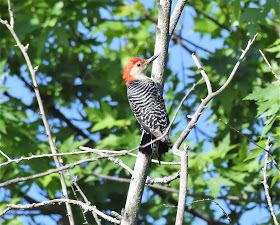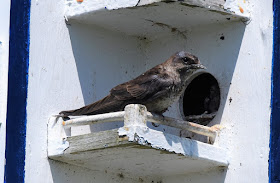Before everyone in Wisconsin had vacation, I had a little time to hang out with my friend Nancy. She lives on this beautiful farm FULL of cool critters. So on this day we spent time with a hummingbird banding team from Milwaukee at her place. Also joining us was new friend and birder Travis. He brought his kiddos to help with the banding project of Ruby-throated Hummingbirds.
 |
| Chimney Swift |
During my time in Wisconsin, I ran surveys for my hometown helping several organizations for our 5th and final year of the Wisconsin Bird Breeding Atlas.
 |
| Canada Goose |
I wore water shoes on several of the trails at Woodland Dunes because the boardwalks were submerged under river water.
 |
| The end of this boardwalk at Woodland's Dunes was completely submerged. |
 |
| Blue-winged Warbler |
I'd monitor the rivers and lakes as well for that breeding information.
 |
| American White Pelican |
May, June and July are especially important months in regards to breeding birds.
 |
| female Red-winged Blackbird
For example, if I saw this female Red-winged Blackbird carrying food, I'd enter that this bird was carrying food.
|
 |
| Clay-colored Sparrow |
Everyone in the state of Wisconsin was working around the clock to collect the data to complete their data blocks on this last year. I could only give a couple hours a day.
 |
| Red-bellied Woodpecker |
 |
| Rose-breasted Grosbeak |
 |
| White-crowned Sparrow |
 |
| Purple Finch |
In Manitowoc county at Nancy's place, we discovered a RARE, for the summer, White-crowned Sparrow. And I was able to confirm a pair of breeding Purple Finches for the atlas. I was not able to see a nest, but food was being gathered. Historically, Purple Finches used to breed during the summer in Manitowoc.
There were a lot of people managing records and checking areas for birds.
Back home, where I could stay close, I watched Purple Martins feed their young. This can be a tricky species to find. They depend entirely on people to provide homes on the eastern half of the US.
Purple Martin populations on the eastern side of the US are declining. And if you don't know where to look for the colonies, they can be very difficult to find. I found 2 breeding colonies in my town. A third colony had collapsed and the population for that area had completely disappeared.
It was fun watching these fast birds snatch butterflies and other insects out of the air and then swirl down to feed their young.
I took notes and lots of documentation. It was an absolute thrill to be able to contribute to the count. Next week, we'll explore the idea of birding near family. Do you document your birds in your area when you find evidence of breeding? Until next time.....












Well you seem to have made good use of your time and obviously were a great help with the counts etc Have a great week ahead.
ReplyDeleteYou do the same! All my best. Chris
DeleteSounds like a lot of fun. We have noticed a huge increase in babies this year especially American goldfinches and Mountain chickadees, but have also seen a number of species we normally don't get here in Alberta. I am hoping the increased numbers are a good sign for the avian populations.
ReplyDeleteIt looks like the West has done well with bird numbers which is a good sign. We had A LOT of rain here this winter so that helped quite a bit with the grasses providing lots of food!
DeleteYour photos Chris as always are stunning. It is fascinating to read of what you and others are doing to contribute to counts and those all important bird records and atlases :)
ReplyDeleteThank you:) So much data getting collected on birds. Anything we can do to help preserve habitats from development!
DeleteWe have had tons of birds this summer with some unusual species as well. Currently lots of baby goldfinches, chickadees, snowy woodpeckers and pine siskins are raiding the feeders in huge droves. I didn't know hummingbirds were banned. How is future info collected.
ReplyDeleteSo we collect data if we find a dead hummingbird OR when they go to other feeders in other countries, etc where they too are also banding hummingbirds. Little tracking devices are now replacing much of the banding. It's tricky work but it's really fun.
DeleteIt seems that 'banding humming birds' is a bit of a blog theme this week! The bands must really be tiny!
ReplyDeleteCheers - Stewart M - Melbourne
Great photos. It's good that you're doing this needed work of banding.
ReplyDelete